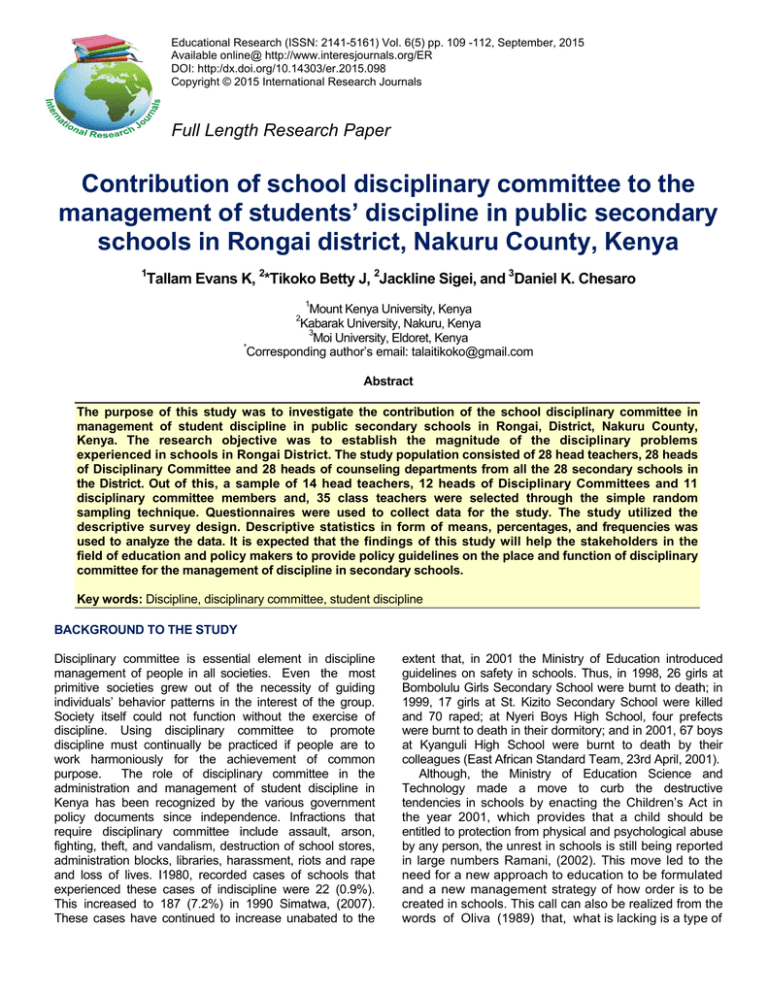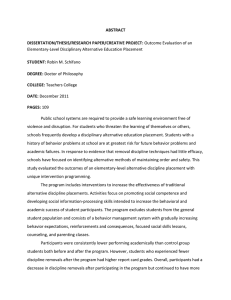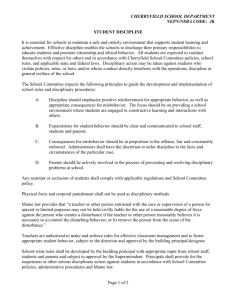Document 14093764
advertisement

Educational Research (ISSN: 2141-5161) Vol. 6(5) pp. 109 -112, September, 2015 Available online@ http://www.interesjournals.org/ER DOI: http:/dx.doi.org/10.14303/er.2015.098 Copyright © 2015 International Research Journals Full Length Research Paper Contribution of school disciplinary committee to the management of students’ discipline in public secondary schools in Rongai district, Nakuru County, Kenya 1 Tallam Evans K, 2*Tikoko Betty J, 2Jackline Sigei, and 3Daniel K. Chesaro 1 Mount Kenya University, Kenya Kabarak University, Nakuru, Kenya 3 Moi University, Eldoret, Kenya * Corresponding author’s email: talaitikoko@gmail.com 2 Abstract The purpose of this study was to investigate the contribution of the school disciplinary committee in management of student discipline in public secondary schools in Rongai, District, Nakuru County, Kenya. The research objective was to establish the magnitude of the disciplinary problems experienced in schools in Rongai District. The study population consisted of 28 head teachers, 28 heads of Disciplinary Committee and 28 heads of counseling departments from all the 28 secondary schools in the District. Out of this, a sample of 14 head teachers, 12 heads of Disciplinary Committees and 11 disciplinary committee members and, 35 class teachers were selected through the simple random sampling technique. Questionnaires were used to collect data for the study. The study utilized the descriptive survey design. Descriptive statistics in form of means, percentages, and frequencies was used to analyze the data. It is expected that the findings of this study will help the stakeholders in the field of education and policy makers to provide policy guidelines on the place and function of disciplinary committee for the management of discipline in secondary schools. Key words: Discipline, disciplinary committee, student discipline BACKGROUND TO THE STUDY Disciplinary committee is essential element in discipline management of people in all societies. Even the most primitive societies grew out of the necessity of guiding individuals’ behavior patterns in the interest of the group. Society itself could not function without the exercise of discipline. Using disciplinary committee to promote discipline must continually be practiced if people are to work harmoniously for the achievement of common purpose. The role of disciplinary committee in the administration and management of student discipline in Kenya has been recognized by the various government policy documents since independence. Infractions that require disciplinary committee include assault, arson, fighting, theft, and vandalism, destruction of school stores, administration blocks, libraries, harassment, riots and rape and loss of lives. I1980, recorded cases of schools that experienced these cases of indiscipline were 22 (0.9%). This increased to 187 (7.2%) in 1990 Simatwa, (2007). These cases have continued to increase unabated to the extent that, in 2001 the Ministry of Education introduced guidelines on safety in schools. Thus, in 1998, 26 girls at Bombolulu Girls Secondary School were burnt to death; in 1999, 17 girls at St. Kizito Secondary School were killed and 70 raped; at Nyeri Boys High School, four prefects were burnt to death in their dormitory; and in 2001, 67 boys at Kyanguli High School were burnt to death by their colleagues (East African Standard Team, 23rd April, 2001). Although, the Ministry of Education Science and Technology made a move to curb the destructive tendencies in schools by enacting the Children’s Act in the year 2001, which provides that a child should be entitled to protection from physical and psychological abuse by any person, the unrest in schools is still being reported in large numbers Ramani, (2002). This move led to the need for a new approach to education to be formulated and a new management strategy of how order is to be created in schools. This call can also be realized from the words of Oliva (1989) that, what is lacking is a type of 110 Educ. Res Independent Variables Dependent Variable Intervening Variables School size School disciplinary Community influence Level of Students’ discipline School rules Parents committee Committee members Discipline records High Medium low Figure 1: The contribution of school disciplinary committee to the management of students’ discipline in public secondary schools in Rongai District. discipline, which empowers an individual to take responsibility for his action in a socially acceptable way. As a result there was need to scrutinize the contribution of school disciplinary committee to the management of school discipline in public secondary schools in Rongai District. Rongai District had its share of problems. Boycotts, strikes and demonstrations were the most common discipline problems experienced in Rongai District. During one of the strikes in 2012, students destroyed property and assaulted two teachers and foreign tourists who were on their journey to Lake Baringo. Statement of the Problem the role of the disciplinary committee to the management of student discipline in public secondary schools in Rongai District, Nakuru County, Kenya. Conceptual Framework The conceptual representation guiding this study was derived from Kounin’s theory (1976) which emphasizes that educators can manage students, lessons and classrooms so as to reduce the incidents of misbehavior. The independent variable is the school disciplinary committee while the dependent variable is the students’ discipline. The intervening variables are aspects like the school size, community influence, and school rules among others. Despite the efforts made by the Ministry of Education to democratize the school administrative system as evidenced by the ban of the cane in schools through Legal Notice No.56 of Kenya Gazette (Supplement No.25:199 of 30th March, 2001), unrest has continued to take toll in secondary schools. Not only are students violent and destructive but they are also premeditated and planned and have caused maximum harm to human life. There seems to be lack of effective alternative strategy to contain student indiscipline. This could be realized from the fact that a good proportion of the country had been experiencing student violence and Rongai District was not exceptional to student violence. It was pertinent therefore, to ask the question; what is the contribution of the disciplinary committee to the management of discipline in schools? Considering this question, the problem of this study was to examine Literature review The Nature and Extent of Students Violence De Wet (2003) states that school violence are not a new phenomenon; even in the 17th century, French schools were faced with sword and fist fights, unrest and attacks on educators. The World Health Organization as cited in De Wet, (2003) defines violence as, “…the intentional use of physical force or power, threatened or actual, against oneself, another person, or against a group or community, that either results in or has a high likelihood of resulting in injury, death and psychological harm”. According to Blandford (1998), it seems as though there is a perceptible breakdown of school discipline Tallam et al. 111 worldwide. In the United States of America, the Annual Gallup Poll of the Public's Attitudes toward the Public Schools concluded that a "lack of discipline" has been identified as the most serious problem facing the nation's educational system Cotton, (1990). In a Harvard Education Letter cited in Cotton, (1990), many educators and learners are said to be gravely concerned about disorder and danger in the school environment. It was further reported that school personnel, pupils and parents call attention to the high incidence of such problems in the school environment as drug usage, cheating, insubordination, truancy and intimidation, which result in countless school and classroom disruptions, and lead to nearly two million suspensions per year in the United States of America. In addition to these school discipline issues, United States classrooms are frequently plagued by other more minor kinds of misbehavior which disrupt the flow of classroom activities and interfere with learning. Furthermore, it was reported that approximately half of all classroom time is taken up by activities other than instruction, and discipline problems are responsible for a significant portion of this lost instructional time Cotton, (1990). According to Osborne as cited in Du Plessis, (2008), school violence should be considered broadly as a group of undesirable behaviors that result in a significantly negative outcome for another learner or entity (such as the school building itself). These behaviors include: Physical violence and fighting, racially motivated violence, verbal abuse, bullying and intimidation, gang violence, drug and alcohol abuse related violence, theft of property and vandalism, Student protests that turn violent, Sexual violence in schools and gender-based violence and violence undermining the education of girls by forcing them out of school. In the Kenyan context, one needs to understand that various factors contributing to the risk of violence are present, such as poverty, neglect, ineffective parenting, dysfunctional family life, high-density housing in townships and informal settlements, diverse racial, ethnic or tribal composition, organized crime, as well as childhood exposure to violence, crime, and the abuse of alcohol and drugs which is reflected in De Wet, (2003). According to Du Plessis (2008), all these factors reverberate in our schools. De Wet (2003) concluded that not only could all of these factors spill over into the schools, with serious consequences for education; they also could lead to a collapse of a learning culture. Blandford (1998) claims that some of the causes of violence in schools are the effects of a poor socio-economic environment, and factors such as drug abuse, child abuse, neglect, and community- and media-related violence, all of which reverberate in many classrooms worldwide. At the same time, however, there are many schools in the world which, regardless of their size, socio-economic influences, student composition or geographic setting, have safe and orderly classrooms and school grounds. Muchemi (The Nation 2001, May 21) gave a chronological account of protests and destruction in public schools. According to Muchemi, the issue of unrests and indiscipline in schools was of great concern. It had become a worrying trend in that it has evolved from simple protests to the destruction of property and burning of prefects. Validity of the instrument This is the extent to which a research instrument measures what it purports to measure,Mugenda and Mugenda, (1999). The content validity of the instrument was determined by the researcher discussing the items in the instrument with the supervisors, colleagues and other lecturers in the university. For the research instrument to be considered valid, the content selected and included in the questionnaires must also be relevant to the variable being investigated. Reliability of the instrument It is the precision or consistency of the test or it is the extent to which the test measures whatever it does consistently. Split-half technique was used to test reliability where it required only one testing session. The split half procedure involved scoring two halves (odd items and even items) of the instruments for each person and the co relation co efficient was tabulated using the spearman’s Brown Prophecy formula.To calculate this, the reliability co efficient score is equals to two times reliability of for half test divided by one plus reliability. The instrument was adopted because the reliability coefficient was0.718.According to Mugenda & Mugenda (1999), a reliability co efficient of over 0.7 is reliable as iteliminates the errors. RESULTS AND DISCUSSION Level of Discipline among Students Discipline in this study refers to abiding by the set rules and regulations in the school. To meet this objective, the respondents were presented with 15 items in the questionnaire regarding the level of discipline among students. The study established that students were not disciplined with a response rate of 80%.Bullying as an aspect of indiscipline in schools also received the same response rate. Students being disobedient with the teachers and prefects, sneaking and students not cooperating with the prefects came second with the response rate of 70%.In the third category, of the response rates of 60% were students not being 112 Educ. Res punctual, fighting ,theft, need for supervision and drug abuse. Three items received a response rates of 60%.These were student unrest being a problem, sexual harassment and students finding difficulties in following the school rules. Finally, two items received a response rate of 40% and these were students having ever staged a strike in the school and neighboring community having a negative impact on school discipline. CONCLUSION Based on the above findings, the study concludes that indiscipline is quite high in most schools and one major indiscipline issue in the schools is bullying. The study further concludes that most schools have a disciplinary committee but they are not effective. Further, BOG is involved in handling serious indiscipline issues in the school. REFERENCES Blandford S (1998). Managing discipline in schools. London and New York: Routledge. Cotton K (1990). School wide and Classroom Discipline. Educational Time Factors. [On-line]: Available url:http://www.nwrel.org/archive/ sirs/5/cu9.html. Accessed 23 August 2011. Daily Nation (2001).Bullying: Students injured in an attack by colleagues. Sunday Nation. Nation media group pp 5. De Wet C (2003). Eastern Cape Educators’ perceptions of the causes and the scope of school violence. Act at Criminological, 16(3), pp. 89-106. Du Plessis AH (2008). Exploring Secondary School Educator Experiences of School Violence. Masters dissertation. University of Pretoria, Pretoria, [online]: South Africa: Available url:http://www. upetd.up.ac.za/thesis/available/etd-06012009-172237/ Accessed: 22, August,2011. Kounin J (1976). Discipline and Group Management in Classrooms. New York: Huntington. Mohapi SJ (2007). The Influence of educators’ life experiences on classroom discipline practices. Phd.T hesis. University of Pretoria. [On-line]: South Africa: Availableurl:http://www.upetd.up.ac.za/thesis/ available/etd-05192008184034/…/00front.pdf.Accessed: 23 August 2011. Mugenda MO, Mugenda GA (1999). Research Methods: Quantitative and Qualitative Approach. Acts Press: Kenya. Oliva FP (1989). Supervision for Today’s Schools. 3rd Edition: New York: Longman Ramani K (2002). “Schools in Dilemma over Discipline.”The East African Standard. Nairobi: The East African Standard Media Simatwa EMW (2007). Management of Student Discipline in Secondary Schools in Bungoma District, Kenya. Unpublished Doctor of Philosophy Thesis in Educational Administration. Maseno University.





